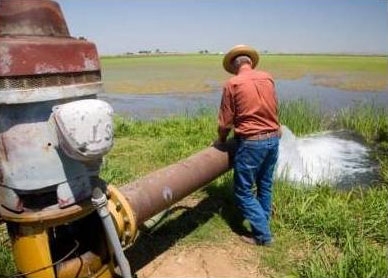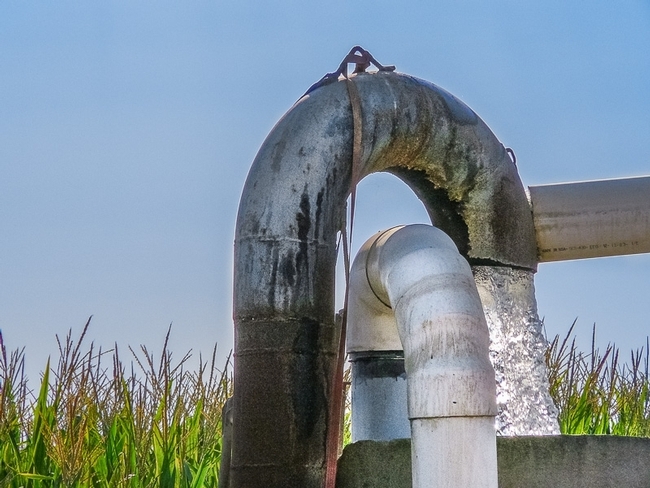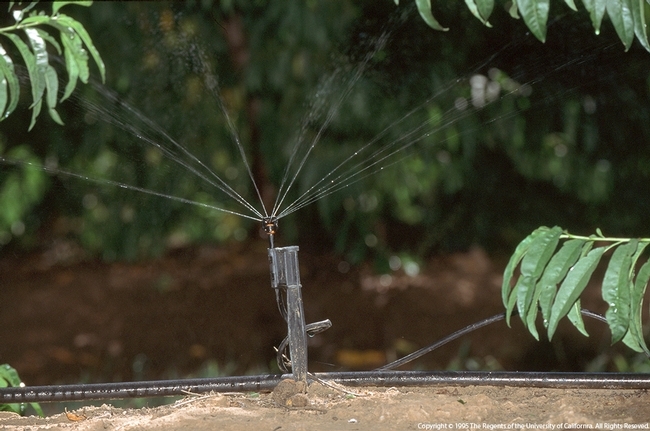Posts Tagged: Thomas Harter
Many landowners believe they own underlying groundwater
Wee sought comment from UC Agriculture and Natural Resources groundwater hydrologist Thomas Harter, a Cooperative Extension specialist based at UC Davis.
"The mentality among landowners is, 'This is really my water,'" Harter said. "'It's part of my property and I don't want anybody to look over my shoulder.'"
Farmers typically use groundwater as a water savings account to draw upon when surface water is unavailable for irrigation. However, after four years of drought and dramatic cuts in surface water allocations, those with more money are drilling deeper wells, often leaving shallower wells high and dry. Removal of the undergound water is also causing land subsidence.
"There are large parts of the southern Central Valley that last year alone have sunk between six inches and a foot," Harter said.
The CNBC report said a recent update on California's drought had gaps in groundwater monitoring. Among the reasons for the data gap: Reluctance of private well owners to grant permission to monitoring entities. Other well owners were hesitant to release well construction details.
Harter said he believes compliance with new groundwater regulations will be challenging.
"People are used to turning on their faucets without thinking about how much they're using," Harter said. "It's a painful process."
California showing signs of groundwater exhaustion
The huge reservoir of water under the soil surface is typically the place where California farmers turn during droughts, when surface water becomes scarce. After three years of drought and persistent groundwater use for water-intensive crops, the water table is dropping steadily, reported Todd Frankel in the Washington Post.
The aquifer accumulated over thousands of years, but is now dropping as much as two feet per year in some parts of the Central Valley. As the water is pumped, the ground sinks down too, said Thomas Harter, UC Agriculture and Natural Resources Cooperative Extension hydrologist based at UC Davis. When the soil compresses, groundwater can never be fully recharged again.
Harter said the state's groundwater reserve reached historic lows last year.
“With little recharge, many areas are currently at the lowest recorded levels ever,” Harter said. “It's worrisome.”
Last year, state lawmakers passed California's first extensive groundwater regulation, allowing for the creation of local boards to oversee how the water is used. But it will take up to two decades before the new law takes full effect.
Groundwater records should be public, says UC ANR expert
Harter, a UC ANR specialist based at UC Davis, and co-author Laurel Firestone, shared their thoughts in an op-ed penned for The Guardian. Firestone is co-executive director of the Community Water Center in California, which helps disadvantaged communities gain access to clean, affordable water.
The authors wrote that state records with information needed to characterize groundwater aquifers are kept confidential under a 64-year-old law that considers them proprietary to well drillers. The well logs contain data that is public in every other state in the West and include details such as where wells are located, their depth, potential pumping rates, diameter and descriptions of the sediments and rocks the wells go through.
"The lack of information is a major impediment to stewardship of the resource," the op-ed says.
California State Senator Fran Pavley introduced Senate Bill 20 in December, which if passed will make well log data publicly available in California.
"Perhaps as more community and farm wells dry up this summer, the legislature will extend its enthusiasm for transparency to the critical information needed for more equitable and sustainable management of our groundwater," Garter and Firestone conclude.
Replenishing California groundwater
For more than a century, California farmers have extracted water from underground to irrigate crops during droughts or where surface water is not available. However, in recent decades, water reservoirs that accumulated over thousands of years underneath the state's valleys are being tapped with deeper and deeper wells that pull out more water than can be replenished in the winter.
The 2012-14 drought intensified the problem. Greater groundwater usage than recharge has left some rural homeowners' wells completely dry. Land is subsiding as clay layers that are interspersed between sandy and gravelly aquifers beneath the surface compress due to lower pore water pressure, which is responsible for keeping clay pores open.
To ensure California's aquifers are available to meet future generations' water needs, proper management in terms of extraction and replenishment is critical, says Thomas Harter, UC Cooperative Extension groundwater hydrology specialist.
Urbanization and advances in agricultural technology have reduced historic groundwater replenishment. Asphalt, concrete and buildings block water infiltration. Water-saving irrigation devices – like drip and microsprinklers – are more protective of groundwater quality, but have reduced the amount of water applied to crops and are cutting down on recharge into the aquifer.
In urban areas, substituting gravel for concrete and leaving areas undeveloped can boost aquifer levels. There is also more that can be done in the agricultural sector to replenish groundwater with clean recharge.
“This will not happen overnight,” Harter said. “But in the intermediate term, it is important to understand how we can use the agricultural landscape to apply additional clean water to recharge the aquifer.”
The project is led by Helen Dahlke, assistant professor in integrated hydrologic sciences at UC Davis and faculty member with the UC Division of Agriculture and Natural Resources Agricultural Experiment Station (AES). The team includes UCCE specialists Harter, Daniele Zaccaria and Samuel Sandoval Solis, AES faculty member Dan Putnam, and UCCE advisors Allan Fulton (Tehama, Colusa, Glenn and Shasta counties) and Steven Orloff (Siskiyou County).
The scientists hypothesize that alfalfa fields and irrigated pastures might be ideal locations for clean aquifer recharge. Both crops demand a relatively low use of fertilizers and pesticides, which means the water soaked down from these fields will be unlikely to carry large amounts of contaminants to the aquifer. The prevalence of flood irrigation in these systems might provide the infrastructure needed to convey surface water, reducing the potential cost of implementing new flood flow capture systems.
The idea is that during storms (or flood control releases) excess surface water could be directed from streams via existing water conveyance systems onto dormant agricultural fields, which would serve as infiltration basins. If successful, tens of thousands acre-feet of water could be recharged annually into California's aquifers during very short periods.
“The banked groundwater would then be available to farmers and municipalities to draw on during dry years,” Harter said.
The project will provide data to address concerns about the costs and risks to crops, the influence these projects may have on groundwater levels and flows, and the possibility of recharging contaminated water or degrading groundwater quality by leaching contaminants such as nitrate into the aquifer.
For more information on groundwater replenishment, see Out of sight but not out of mind: California refocuses on groundwater in the July-September 2014 issue of California Agriculture journal.
An initiative to improve California water quality, quantity and security is part of the UC Division of Agriculture and Natural Resources Strategic Vision 2025.
Farmers of the future will be happy about 2014 groundwater regulations
The new groundwater laws that Gov. Brown is expected to sign may not be popular with today's farmers, but tomorrow's farmers likely will look back with gratitude, reported Bettina Boxall in the Los Angeles Times.
"Some farmers are going to be having to cut back at least in the short run," said Doug Parker, director of the UC California Institute for Water Resources.
Thomas Harter, UC Cooperative Extension specialist in the Department of Land, Air and Water Resources at UC Davis, predicted the farmers' successors will appreciate the coming regulations.
"In the long run, my view is that the next generation and two generations down of farmers will find this a lifesaver," Harter said.
The bills waiting for the governor's signature won't provide an instant fix, the story said. The law will take years to implement and it could take decades for the most depleted groundwater basins recover.
In most years, groundwater amounts to 30 to 45 percent of the state's water supply, but in dry periods, it increases to 60 percent. The new law will direct local public agencies to develop sustainable groundwater management plans. If they fail, the State Water Resources Control Board steps in. The legislation gives local basin managers the ability to:
- Collect fees from groundwater users
- Monitor withdrawals
- Limit pumping
- Buy water or water rights to replenish aquifers
The Association of California Water Agencies supports the new regulations; agricultural interests are opposed, the article says.
"We thought these bills were too far-reaching," said Paul Wenger, president of the California Farm Bureau Federation.







